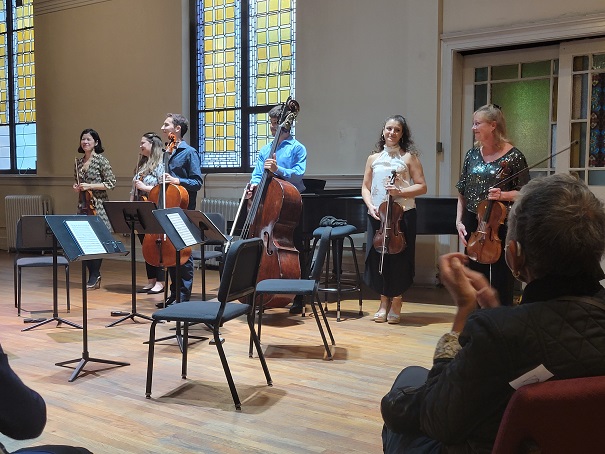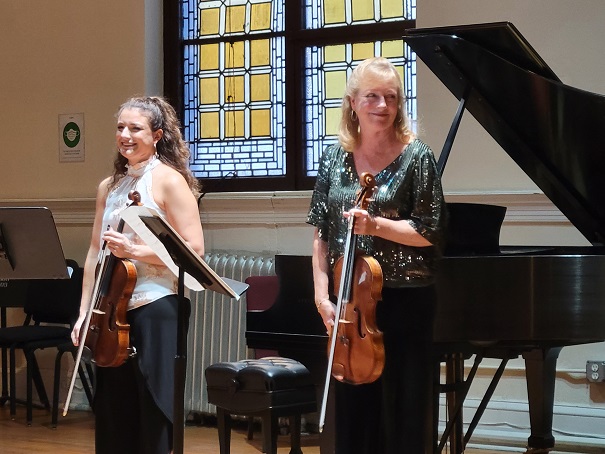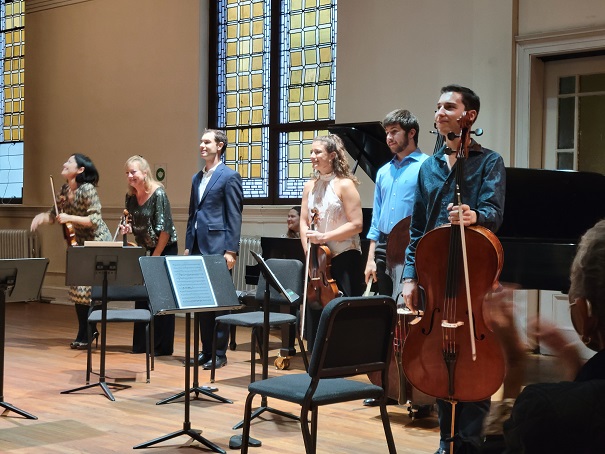Concert Diary: “Showstoppers” with the Jupiter Players
November 11, 2021
New York, N.Y.
Of the music written for solo violin, Bach’s three Sonatas and three Partitas rank supreme. Musically, they are a delight, but technically they seem impossible. The second movement of the first sonata, for example, is a three-part fugue! Bach has written this fugue so that the three voices can be clearly articulated by a single violinist, but it remains a marvelous feat both in composition and performance.
Fugues are most commonly realized on keyboard instruments, and Bach wrote plenty of those as well both for harpsichord and organ. It doesn’t make much sense to transcribe Bach’s solo violin music for keyboard, but it has been done.
Indeed, this past Monday’s concert of the Jupiter Symphony Chamber Players began with the first two movements of Bach’s Sonata No. 1 for solo violin (BWV 1001, c. 1720) as transcribed for piano by German-Swiss composer Joseph Joachim Raff (1822 – 1882) in 1869. These two movements are an Adagio and that three-part Fugue I mentioned above. (If you’re curious enough to examine the scores of the original and transcription, IMSLP has them: Bach’s original and Raff’s transcription.
The result was fascinating to hear! Raff’s arrangement (performed by pianist Drew Petersen) retains the core of Bach’s music, but surrounds it with many more notes and chord completions that create a kind of romantic lushness that is certainly non-Bachian but suggests how the 19th century viewed Bach following the rediscovery of his music.
Joseph Joachim Raff was apparently quite a famous composer in his day, so I was happy that the Jupiter Players followed his Bach transcription with the composer’s completely original String Sextet in G Minor, Op. 178 of 1872. I loved the shimmering opening, the tempest at the end of the first movement that dissolved in quiet pizzicato, the fast skittering dance of the second movement Scherzo, the sudden pleasant country outing of the Trio section, the inventive and witty theme and variations of the third movement, and the fast driving finale punctuated with dramatic slowdowns. (There’s a recording of Raff’s Sextet on Spotify; check it out.
Here are the Jupiter Players in curtain calls following the Raff Sextet:
Following intermission was another connection with the Baroque era. Dating from about 1720 is Handel’s Suite in G Minor for harpsichord (HWV 432) with a Passacaglia finale. In 1893, Norwegian violinist Johan Halvorsen seems to have started transcribing the Passacaglia for violin and viola, but then continued by creating his own variations on Handel’s theme. In 1935, Lionel Tertis — who is sometimes credited with elevating the viola into its current prominence — decided to go beyond Halvorsen with his Variations on a Passacaglia by Handel for two violas. Very rarely do we hear two violas alone together, so that was a treat in itself. Tertis’s variations are short — 31 of them in just 8 minutes — and they are both virtuosic and harmonically daring. The unusual harmonies shouldn’t have been surprising considering that the work was composed in 1935, but I didn’t expect that to be an element of a composition highlighting the viola.
The performance by Milena Pajaro-van de Stadt and Cynthis Phelps was exquisite. Here they are in curtain calls:
The concert concluded with a well-known composer, Felix Mendelssohn, but with a work composed when he was just 15 years old. This is the Piano Sextet in D Major from 1824, for piano, violin, two violas, cello, and bass. (That’s right: one violin and two violas.) It must have been performed by Mendelssohn and his friends at the time (although there is no historical evidence for that), but was only published posthumously as Op. 110, The work seems to straddle the classical and romantic eras, with a piano part that was so prominent (and apparently so difficult) that at times this work seemed to become a piano concerto. Here are the Jupiter Players taking a curtain call:


